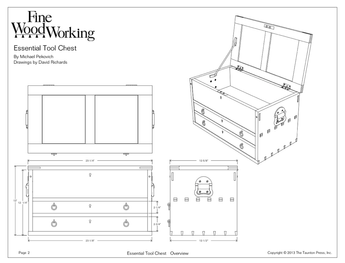I’m confused about the appropriate use of Penetrol. Is it for use only with brush or roller application, or does it also help when using a spray unit??
Discussion Forum
Get It All!
UNLIMITED Membership is like taking a master class in woodworking for less than $10 a month.
Start Your Free TrialCategories
Discussion Forum
Digital Plans Library
Member exclusive! – Plans for everyone – from beginners to experts – right at your fingertips.
Highlights
-
Shape Your Skills
when you sign up for our emails
This site is protected by reCAPTCHA and the Google Privacy Policy and Terms of Service apply. -
 Shop Talk Live Podcast
Shop Talk Live Podcast -
 Our favorite articles and videos
Our favorite articles and videos -
E-Learning Courses from Fine Woodworking
-
-
 Fine Woodworking New England Event
Fine Woodworking New England Event -












Replies
I use it for spraying it is just a retarder.Re your other thread I find that bin is rather fast for spraying and it tends to orange peel .Get a suggestion from Zinnser on how to slow its flash.Maybe a shot of mineral spirit would work in BIN
Thanks, Jako. Actually, a retarder is probably the opposite of what I want with this paint. I've been using Benjamin Moore Impervo, an alkyd, in a low-lustre version. It comes from the can extremely thick. I finally got the straight scoop from a painter, conversing next to the cash register, and he suggested cutting it with 10%-20% Naptha. I used 15% and it worked much, much better for brushing, but I decided to try spraying (brush technique is seriously lacking). I added a touch of Japan drier to the first batch, but for this second one I left that out. It seems to be drying fairly quickly, but still leveling out well.
The original formula, from the can, takes forever and a week to dry! This thinned stuff works well in my little Wagner sprayer, but to be cautious (time's awastin' at this point), I'm spraying it on and actually tipping off with a brush. When this project's completed, I'll try a sample board with just spraying and see how well it levels. The little gun doesn't have any adjustments other than quantity of material.forestgirl -- you can take the girl out of the forest, but you can't take the forest out of the girl ;-)
I have used Penetrol in oil based paints (mostly marine) on boats for years to retard the set up so that it would flaten out and not show any brush marks. It worked great but I never used it with water based paints. Never sprayed it either.
Len
The spraying is what I'm curious about. Penetrol is for oil-based paints. There's a different product for water-based, name escapes me at the moment.
Ah! Flowtrol? Floetrol? Something like that.
forestgirl -- you can take the girl out of the forest, but you can't take the forest out of the girl ;-)
Edited 6/29/2007 12:38 pm by forestgirl
Penetrol will retart any oil base paint, that is what it is supposed to do, it allows the paint to flatten out any eliminate the brush or roller marks.
If you want to thin an oil base paint and have it dry faster thin with naptha and then spray. I would suggest you test different ratio before doing your final product.
I'm just starting to learn about the whole thing of modifying paint, spraying, etc., etc. Had (have) no idea if Penetrol is something that can/should be used with spray units. Ideally, what I'd want with the Impervo would be to have it thin enough to spray, but retarded long enough to level out. Which leaves me wondering if thinning with Naptha and then adding Penetrol would work well, or if it'd make more sense to thin with mineral spirits. Too many options, just starting to understand the basics.forestgirl -- you can take the girl out of the forest, but you can't take the forest out of the girl ;-)
I'm sory but I never used a water based paint. With the oil based paint I never measured the amount of Penetrol, just added a little, tried it with aew brush stokes and made any adjustments I felt it needed. Very scientific! I also never tried to spray it (I'm going back 30 years or more when ther was still a lot of wooden boats around.)
Len
http://www.flood.com/flood/CustomerSupport/FAQ/DIY/Penetrol+FAQ.htm
Don't have the can nearby but we used penetrol and floetrol for rolling, brushing and spraying paint.
Thanks, Rick. I'm jotting these questions at Knots inbetween tasks, hadn't taken the time to find their web site. The other thing I'm quickly learning is that reading the cans for any of this stuff, especially the paints themseves, tells me aboslutely squat about how people actually use it to get good results! Gotta get it straight from the guys/gals who use it! That be you!
forestgirl -- you can take the girl out of the forest, but you can't take the forest out of the girl ;-)
Edited 6/29/2007 6:41 pm by forestgirl
I use penetrol whenever I brush - which is all that I do - no room for a spray set-up. (Is that spelled right? I should go look at the can.)
I have found that it really, really helps with leveling out, but that paint so treated takes several weeks to really harden up. It dries normally, but seems to take longer to get hard enough to resist easy scratching.As to thinning, I've read and been told that thinning by about 15% is necessary for good control and flow-out, regardless of the paint or application method, but that the manufacturers are prevented from advising us of this because that increases VOC's, and the SCAQMB (Southern California Air Quality Management Board) will ex-communicate any paint mfg who does so.Mike D
I have used BM products, and Satin Impervo in particular since forever. I always use Penetrol since it makes brushing the paint out dramatically easier.However, I have never considered Penetrol to be a thinning agent, and as far as I can tell, it doesn't thin the paint. For that I would use either paint thinner or naptha, but I would still use the Penetrol. As far as spraying is concerned, yes, my understanding has always been that Penetrol is useful for that purpose. However, because it is so slow drying (like any alkyd paint), I have only sprayed it once or twice. And then, I did thin the paint out (by 10-15%) with paint thinner. I have always brushed SI, and if you use Penetrol, a white china bristle brush, and sand between coats, it yields a really beautiful, smooth finish -- with no discernible brush marks. I've used this technique for casings, doors, and cabinets: BM alkyd enamel underbody (a primer), plus two coats of SI.********************************************************
"It is what we learn after we think we know it all, that counts."
John Wooden 1910-
Ahhhh, an Impervo expert. My dreams come true! This paint seems so "respected" by those who use it, I'm determined to learn the secrets myself, LOL.
No fear that I was seeing Penetrol as a thinning agent, I know that's not its purpose. Ah, I'm deflated by your "no discernable brush marks" comment -- I sure haven't gotten there yet, but there's hope! Question: Do you find, as Mike does, that the Penetrol slows down drying to a great degree?? That's of concern to me, as I don't want to get in a situation where I finish a project and have to store it for two weeks before sending it off to a customer.
Another question: When you brush with SI, do you thin the paint at all? I can't believe how thick it is right out of the can.
Hope you don't mind the detailed questions. It seems they must be asked to get info needed to do a good job. Stuff's too expensive to be doing a bunch of shop experiments to develop an approach independently!forestgirl -- you can take the girl out of the forest, but you can't take the forest out of the girl ;-)
How long have I used Satin Impervo? Well, when I first started with it, the wholesale price was somewhere around $20/gal. I don't necessarily say it is the best paint, but it is easily available to me, and there is much to be said for using a particular paint until you are intimately familiar with its qualities and idiosyncrasies.Thinning: As you are aware, the changing VOC regs have forced mfgrs to alter their formulas over the years, and SI is now noticeably thicker than it was a few years ago. So yes, I always thin it, along with adding Penetrol. I can't tell you exactly how much I thin it, since I just dump thinner into my container until it's about the consistency "it used to be." I know that is not helpful, but you certainly don't want the paint to seem watery. I suppose the rule is, add a little paint thinner, and if it still seems too thick when brushing, add a little more.WHITE CHINA BRISTLE BRUSH. My paint store sells a cheap brand (Yachtsman), and a 2 1/2" sash brush (which is what I use 95% of the time) costs about $12.I also use brushes with black China bristle, but the whites are softer, and give the best finish when you are especially particular. I use a proprietary brush cleaner, followed by soap and water, then wrapping the bristles in a folded paper towel with a rubber band around the ferrule. I'm still using brushes that have been in the inventory for 10-15 years.I have a set of brushes for varnish and another set for alkyd painting, and I never interchange them. DRYING TIME. If the weather is humid, I never recoat before 24 hours (i.e. not "overnight"). Generally, during the winter here, you can get away with the overnight dry.Personally, I don't think Penetrol has any effect on drying time. In any event, if the sandpaper "corns" up, you know you have to wait longer. Even when dry to the touch, SI takes a full seven days to cure, which is a consideration only if the painted object will be put to hard use (like a shelf). PRIMERS. I think primers matter, and I only use two under SI, and both are Ben Moore products. If I'm in a hurry, I will use Latex Enamel Underbody, and if I want a "primo" finish, I use Alkyd Enamel Underbody. Both are are part of the "Fresh Start" line from BM.No matter which of the primers I use, I do two coats of SI, sanding carefully between the first two (primer, 1st coat of SI).BRUSHING TECHNIQUE. Easier to show than articulate.But basically, I load the brush, dump it on the surface, spread it about (always with the grain), and then carefully tip it off.The only skill here is knowing about how much paint to "dump" on the surface, and then mastering the "tipping off" technique. It's not hard.I tend to paint fast, and apply paint liberally. SI has a slight tendency to sag on vertical surfaces, and part of the skill is knowing exactly when to "re-tip" these vertical surfaces. SI will start to skin-over in about five or so minutes, and you want to do your re-tipping just before that point. If I am especially fussy about the paint job on a given project, I will use a 2" foam brush for the tipping off process.I think that addresses all the questions you raised. But let me hasten to say that I am not arguing this collection of products, methods, and techniques is the "best" or "only" way to go. It's just that over a long period of time, it's what I have worked out for myself. ********************************************************
"It is what we learn after we think we know it all, that counts."
John Wooden 1910-
I want to thank you, Nikkiwood, for all the details you've taken the time to explain. I printed this off yesterday, and will be reviewing it as soon as I get through the stuff I'm doing right now. Appreciate it!!!forestgirl -- you can take the girl out of the forest, but you can't take the forest out of the girl ;-)
PS: I used B.I.N. (shellac-based) as a primer. Would the BM primer be a significantly better product to use??
White China bristle: Not sure I've seen the white ones at the store, black ones yes. There's a noticeable difference? [edit: just looked them up on the Sherwin Williams site, I see. I might not have thought to use one with the alkyd paint. Thanks for the tip.] Learning to take care of them, for sure, as the good ones ain't cheap!
forestgirl -- you can take the girl out of the forest, but you can't take the forest out of the girl ;-)
Edited 6/30/2007 10:25 am by forestgirl
Nikkiwood wrote "However, I have never considered Penetrol to be a thinning agent"Ah, I should have made myself clearer (more clear?). I both THIN by 15% using mineral spirits to improve brush-ability (I'm sure that's a word), AND, I add the recommended ounces of Penetrol to improve flow-out and eliminate the appearance of brush strokes. Both steps improve the brushing characteristics of oil-based paints.I have READ that adding mineral spirits speeds drying, but that adding pure turpentine (with a not too high of a resin content) in place of the mineral spirits actually slows the drying process. I don't have enough experience to say if this is so or not. Do any of you painting gurus know?Mike D
We're on the same page re: Penetrol. I have always used plain paint thinner to thin paints (and varnishes). I really don't know what advantage there might be to turpentine -- except perhaps to make a stinky product even stinkier. <g>********************************************************
"It is what we learn after we think we know it all, that counts."
John Wooden 1910-
Re turpentine... Well, my Dad and uncles used it - it was what you used.I've recently read that the turpentine available today is not much like what our Dad's used way back when. According to the article, today's turpentine has a resin content that varies wildly across the spectrum, depending on which variety of tree was used as the resource for distilling it. As a result, one can might be a dandy paint thinner, and the next might result in a gummy, sticky mess that never completely dries. I really don't know if this is a factual representation or not, but based on it's possibility, I think that I'll avoid it's use as a thinner, as well.Mike D
"...but that paint so treated takes several weeks to really harden up." That was an extremely valuable bit of information, Mike, thanks. Can't have that kind of situation when I making something for someone else, especially a paying someone!
These two units may tell me how much of a difference the Japan drier makes, as I didn't add it for the second unit. I understand about the manufacturers having their hands tied (hence the "do not thin" on the cans). Am surprised, though, that the folks at the paint store couldn't give me more helpful info. It was only when I talked to a painter that things got more clear. This store is where all the island's contractors, subs, decorators, et al., go for paint. They've been in business for years.
Making room for spraying was tough. There's an 8x8' area screened off with plastic, including a ceiling. No hope of doing any other serious shop work in the interim. Yearn for a little separate area for finishing, dust-free with a fan! There was a very interesting suggetion for ventilating a plastic-surround spray booth in this post at WWA, look down the page for R. Petersen's post. I'm going to run it by JWW and see what he thinks, welcome your thoughts also.forestgirl -- you can take the girl out of the forest, but you can't take the forest out of the girl ;-)
I think you can use it for any application where you want it to flow out. The following article by Jeff Jewitt talks about its sister, Floetrol(used for w/b products), how it differs from a thinner, and what it does.
http://www.homesteadfinishing.com/pdf/paintspraying_ver2.pdf
Turpentine is a little slower than mineral spirits. Some people who use it claim it has a different feel when brushing.
http://www.violinvarnish.com/turpentine.htm
Great and informative links.
Thanks
Mike D
This forum post is now archived. Commenting has been disabled